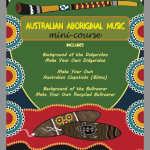Instruments from Australian Aboriginal culture are wonderfully easy to make and play. Whether you’re turning a cardboard roll from wrapping paper into a working didgeridoo or a broomstick into “bilma” clapsticks, these projects are creative, artistic and encourage your children to feel connected to world traditions as young global citizens.
If you’ve seen any movie or video about Australia, you’ve heard the sound of a didgeridoo. Although traditional didgeridoos are made from long branches hollowed out by termites, modern ones can be crafted from pvc piping or the sturdy cardboard rolls found inside paper towels or wrapping paper.
Playing the basic sound of a didg can quickly be mastered by kids and adults alike! If you can “blow raspberries” (pucker your lips and blow air out while the lips flap back and forth a bit), then you can make a didg drone. Sound clips, coloring pages and easy instructions on making a homemade didg can be found at the link below.
The Didgeridoo – A Legacy of Kindness
Along with being a unique instrument, the didgeridoo comes with a wonderful origin story. You can read about how this instrument was created by a thoughtful elder who was so kind that he would not harm an ant. The Legend of the Didgeridoo can be found at the link below.
Almost every culture has discovered clapsticks – two pieces of wood, held in the hand and tapped together to make a beat. In Australia, clapsticks are called bilma and can be as simple as two sticks found in the woods or as elaborate as the decorated ones pictured here. Bilma are frequently used as part of ceremonies along with a didgeridoo. Special bilma made of hardwoods; such as mahogany, have a beautiful tone and can be heard for long distances.
Stay tuned for our next post where we share easy and fun methods for making and decorating bilma clapsticks with kids.
If you don’t mind getting outside and can find a bit of elbow room, a recycled water bottle makes a fine bullroarer. Directions and a video of this really unique instrument can be found in the Links and Resources section below.
You Gotta Didg!
If you haven’t watched it yet, check out the video at the top of this article that features a didgeridoo and bullroarer. It’s a music video of DARIA’s “You Gotta Didg” song. The animation shows didgeridoos being played, beautiful Aboriginal face and body paint and the sacred site of Uluru in Australia, formerly known as Ayers Rock. Like the song? Add it to your Spotify, Apple Music or Pandora playlists at the links below.
Links and Resources
“You Gotta Didg” on Spotify: https://open.spotify.com/track/3j6k7ftRC13AFWFAz9ZXza
On Apple Music https://itunes.apple.com/us/album/beautiful-rainbow-world/id208109471
On Pandora: https://www.pandora.com/artist/daria-childrens/AR3qdptJ5Vzh7r2
 Hear, Color or Create A Recycled A Didgeridoo
Hear, Color or Create A Recycled A Didgeridoo
http://www.dariamusic.com/didgeridoo.php
What is a Didgeridoo Freebie: https://www.teacherspayteachers.com/Product/What-is-a-Didgeridoo-2816257
Australian Instrument Mini-Course: https://www.teacherspayteachers.com/Product/Australian-Aboriginal-Instruments-Music-Mini-Course-2816723
Legend Of The Didgeridoo
http://makingmulticulturalmusic.wordpress.com/2012/08/24/the-legend-of-the-didgeridoo/





